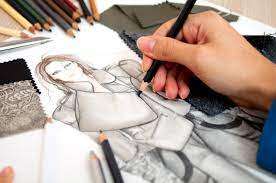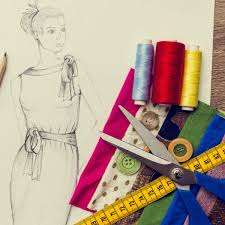WHAT IS FASHION DESIGNING

August 01, 2023
WHAT IS FASHION DESIGNING
Fashion designing is the art and profession of creating designs for clothing, accessories, and other fashion products. It involves the application of various techniques, creativity, and a deep understanding of aesthetics, trends, and consumer preferences. Fashion designers use their skills to conceptualize and produce original and innovative designs that cater to different market segments and reflect the latest fashion trends.
The process of fashion designing typically begins with research and trend analysis, where designers gather inspiration from various sources such as art, culture, history, and current fashion movements. They then sketch or create digital renderings of their design ideas, taking into consideration factors such as fabric selection, color palettes, and garment construction techniques.Once the initial designs are developed, fashion designers may create prototypes or samples to test their ideas and make necessary modifications. They collaborate with pattern makers, fabric suppliers, and manufacturers to bring their designs to life. Fashion designers also play a crucial role in choosing fabrics, trims, and embellishments that enhance the visual appeal and functionality of the garments.
Fashion designers often work within specific categories or niches, such as women's wear, men's wear, children's wear, haute couture, sportswear, or accessories. They may work independently as freelancers, establish their own fashion labels, or be part of a design team in a fashion house or a manufacturing company.Overall, fashion designing is a dynamic and multifaceted field that requires a combination of artistic talent, technical skills, industry knowledge, and a keen sense of style to create visually striking and commercially viable fashion products.
HOW TO BECOME A FASHION DESIGNER
CREATIVITY :
Start by honing your artistic skills and nurturing your creativity. Take drawing and sketching classes to improve your ability to visualize and communicate design ideas. Familiarize yourself with different fabrics, colors, and trends by studying fashion magazines, attending fashion shows, and exploring fashion history.
FASHION DESIGNER COURSE :

While not always necessary, formal education can provide a solid foundation for a career in fashion designing. Consider enrolling in a fashion design program at a reputable fashion school or university. Look for programs that offer courses in design principles, garment construction, pattern making, textiles, and fashion illustration.Seek opportunities to gain hands-on experience in the fashion industry. Look for internships or entry-level positions with fashion designers, fashion houses, or clothing manufacturers. This will help you understand the practical aspects of the industry, build a network of contacts, and develop your skills further.
STAY UPDATED WITH TRENDS AND INDUSTRY KNOWLEDGE :
Stay informed about the latest fashion trends, industry news, and technological advancements. Attend fashion shows, exhibitions, and trade fairs to gain insights into the current fashion landscape. Follow fashion blogs, magazines, and social media accounts to stay inspired and connected with the industry.
NETWORK AND COLLABORATE :
Build relationships with other professionals in the fashion industry. Attend fashion events, join professional associations, and connect with fellow designers, stylists, models, and photographers. Collaborating with others can help you expand your network, gain exposure, and explore new opportunities.
WHAT IS FASHION DESIGNING COURSE
DESIGN PRINCIPLES :
Courses typically cover the fundamental principles of design, including color theory, proportion, balance, and silhouette. Students learn how to translate their creative ideas into visual representations through sketching and illustration techniques.
GARMENT CONSTRUCTION AND PATTERN MAKING :
Understanding the construction of garments is essential for fashion designers. Courses teach students about fabric selection, draping, sewing techniques, and pattern making. Students learn how to create patterns and construct garments from scratch.
TEXTILES AND MATERIALS / FASHION HISTORY AND TRENDS :
Courses cover the study of different textiles, fabrics, and materials used in fashion. Students learn about their properties, characteristics, and appropriate applications. They gain knowledge about fabric manipulation, embellishments, and surface treatments.Fashion designing courses often include the study of fashion history, influential designers, and significant fashion movements. Students gain an understanding of the evolution of fashion and how historical trends influence contemporary designs.
FASHION ILLUSTRATION AND COMPUTER-AIDED DESIGN (CAD) :
Drawing and illustration skills are crucial for fashion designers. Courses teach students different techniques for illustrating garments and creating fashion sketches. Additionally, CAD software training is provided to familiarize students with digital design tools commonly used in the industry.
FASHION MARKETING AND BUSINESS :
Many courses include modules on fashion marketing, branding, and business aspects. Students learn about market research, consumer behavior, fashion merchandising, and retail strategies. They gain knowledge of how to position their designs in the market and understand the business side of the fashion industry.
HOW TO BECOME A FASHION DESIGNER AFTER 12TH
RESEARCH FASHION DESIGN PROGRAMS:
Look for reputable fashion design schools or institutions that offer undergraduate programs or diploma courses in fashion design. Research their admission requirements, curriculum, faculty, and industry connections.
CHOOSE THE RIGHT COURSE:
Evaluate your interests, career goals, and financial situation to select a suitable course. Consider factors such as program duration, specialization options, practical training, and internships offered.
ENROLL IN A FASHION DESIGN PROGRAM:
Apply to the fashion design program of your choice and complete the admission process as per the requirements of the institution. Ensure that you meet the eligibility criteria and submit all the necessary documents.
LEARN THE FUNDAMENTALS:
Once you begin your fashion design program, you will learn the fundamentals of design, garment construction, pattern making, textile studies, fashion illustration, and more. Pay attention to theory and practical classes to develop a strong foundation.
DEVELOP YOUR SKILLS:
Take advantage of the resources provided by your institution, such as design studios, sewing labs, and workshops. Practice sketching, drawing, and creating fashion illustrations. Gain hands-on experience in fabric selection, draping, and garment construction.
GAIN PRACTICAL EXPERIENCE:
Look for internships or apprenticeships with fashion designers, fashion houses, or manufacturers. This will provide valuable industry exposure, enhance your skills, and build a network of contacts. Apply for internships through career placement services at your institution or search for opportunities independently.
CONSIDER FURTHER EDUCATION:
After completing your undergraduate program, you may choose to pursue higher education in fashion design, such as a master's degree. This can provide advanced knowledge, research opportunities, and specialization options.
LAUNCH YOUR CAREER:
Once you feel ready, start applying for entry-level positions in fashion design or launch your own brand. Leverage your portfolio, network, and internship experiences to secure job opportunities. Stay persistent, flexible, and open to different paths within the fashion industry.





